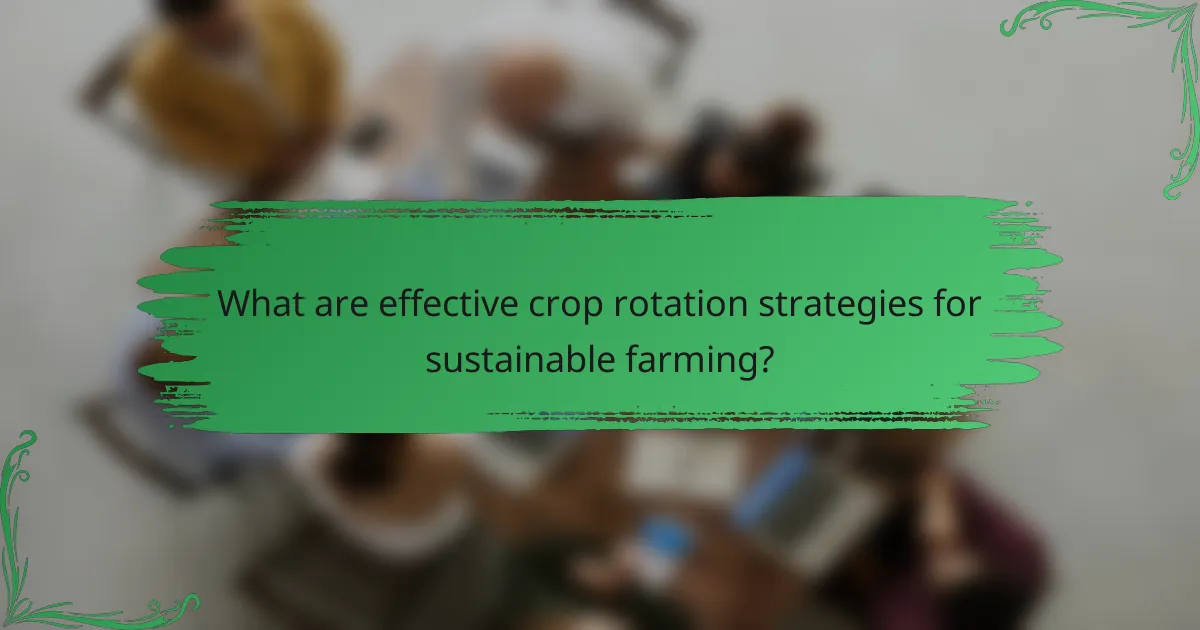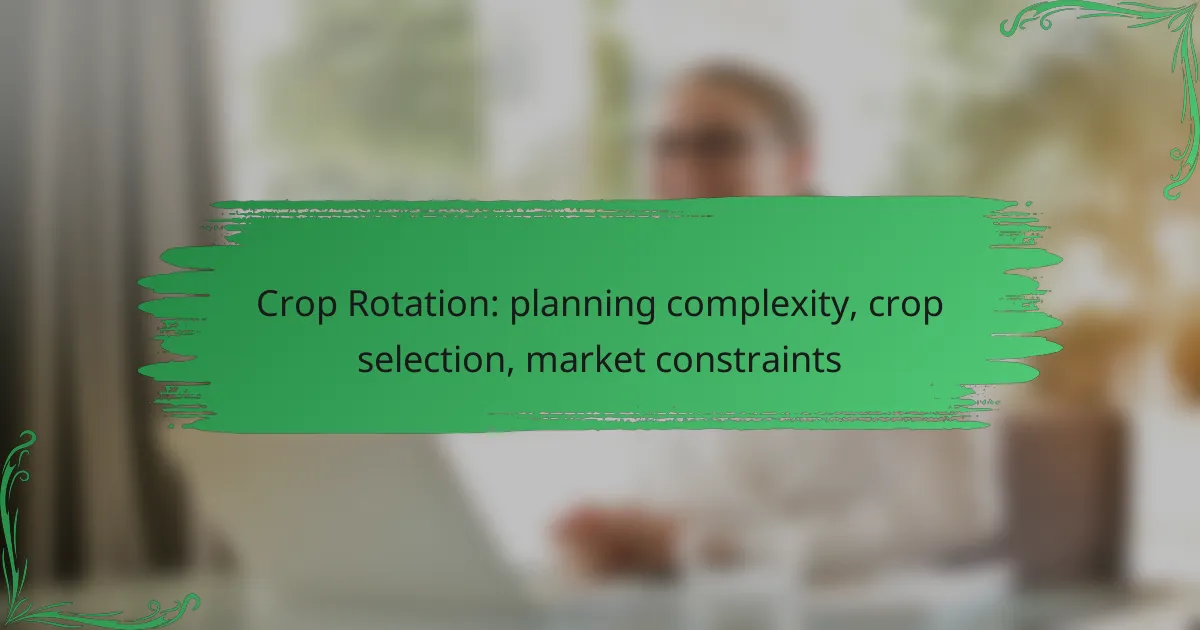Crop rotation is a vital practice in sustainable agriculture that requires careful planning to enhance soil health and optimize yields. Selecting the right crops involves considering local climate, soil types, and market demands, while also navigating economic constraints that can impact profitability. Understanding these complexities is essential for farmers aiming to implement effective crop rotation strategies that align with both environmental and market needs.

What are effective crop rotation strategies for sustainable farming?
Effective crop rotation strategies for sustainable farming involve planning the sequence of different crops to enhance soil health, manage pests, and optimize yields. Key strategies include using legume cover crops, promoting crop diversity, implementing sequential cropping, improving soil health, and managing pests effectively.
Legume cover crops
Legume cover crops, such as clover or vetch, are planted during off-seasons to fix nitrogen in the soil. This natural fertilization reduces the need for synthetic fertilizers, promoting sustainability. Incorporating legumes into the rotation can improve soil structure and enhance moisture retention.
When selecting legume cover crops, consider local climate and soil conditions. Aim to plant them in the fall or early spring, allowing them to grow before the main crops are sown. This practice can lead to healthier, more productive soils over time.
Crop diversity
Crop diversity involves rotating various types of crops to break pest cycles and reduce disease prevalence. By planting different families of crops, farmers can enhance biodiversity, which contributes to ecosystem resilience. This strategy can also improve market opportunities by catering to different consumer demands.
To implement crop diversity, consider rotating grains, legumes, and vegetables. For example, following a corn crop with soybeans or a mix of vegetables can yield better results. Aim for at least three different crops in a rotation to maximize benefits.
Sequential cropping
Sequential cropping refers to planting multiple crops in a single growing season. This method maximizes land use and can increase overall productivity. Farmers can benefit from higher yields by selecting fast-maturing crops that can be harvested before the next planting.
For successful sequential cropping, choose crops that complement each other in nutrient requirements and growth cycles. For instance, following a quick-growing radish with a longer-season crop like corn can optimize the use of resources and improve soil health.
Soil health improvement
Improving soil health is a fundamental aspect of effective crop rotation. Practices such as adding organic matter, maintaining proper pH levels, and ensuring adequate drainage can enhance soil fertility and structure. Healthy soils support robust crop growth and resilience against pests and diseases.
To improve soil health, regularly test soil conditions and amend as necessary. Incorporating compost or well-rotted manure can provide essential nutrients. Aim for a balanced approach to soil management that considers both chemical and biological factors.
Pest management
Effective pest management through crop rotation involves disrupting pest life cycles by alternating crops that pests target. This strategy reduces reliance on chemical pesticides and promotes a more balanced ecosystem. Certain crops can naturally repel pests, further enhancing this approach.
To implement pest management through rotation, identify crops that are less susceptible to specific pests. For example, rotating brassicas with legumes can help control aphid populations. Regular monitoring and adjusting the rotation plan based on pest activity can lead to more sustainable farming practices.

How to select crops for rotation in North America?
Selecting crops for rotation in North America involves understanding local climate, soil types, market demands, and crop compatibility. A well-planned rotation can enhance soil health, optimize yields, and improve profitability.
Climate considerations
Climate plays a crucial role in determining which crops can thrive in a specific region. Factors such as temperature, rainfall patterns, and growing season length should guide your crop selection. For instance, warmer regions may favor crops like corn and soybeans, while cooler areas might be better suited for barley or oats.
Additionally, consider the risk of extreme weather events, such as droughts or floods, which can impact crop viability. Selecting drought-resistant varieties or crops that can tolerate excess moisture can mitigate these risks.
Soil type analysis
Understanding your soil type is essential for effective crop rotation. Different crops have varying nutrient requirements and root structures, which can affect soil health. For example, legumes like peas and beans can fix nitrogen in the soil, benefiting subsequent crops.
Conduct soil tests to assess pH, nutrient levels, and organic matter content. This information will help you choose crops that can thrive in your soil conditions and improve overall soil fertility over time.
Market demand assessment
Evaluating market demand is vital for selecting profitable crops. Research local markets, consumer preferences, and pricing trends to identify which crops are in high demand. Seasonal crops may offer better prices during peak seasons, while staple crops can provide consistent income.
Consider diversifying your crop selection to mitigate risks associated with market fluctuations. Growing a mix of high-demand and staple crops can balance potential income and ensure financial stability.
Crop compatibility
Crop compatibility refers to how well different crops can be grown together in a rotation. Some crops can enhance the growth of others, while others may compete for nutrients or harbor pests. For example, rotating corn with soybeans can improve soil nitrogen levels and reduce pest populations.
Implementing a diverse rotation plan can help break pest and disease cycles, leading to healthier crops. Be mindful of the specific needs and growth habits of each crop to maximize the benefits of your rotation strategy.

What are the market constraints affecting crop rotation?
Market constraints significantly influence crop rotation decisions by dictating which crops are viable based on current economic conditions. Factors such as price volatility, consumer preferences, export regulations, and local competition all play crucial roles in determining successful crop planning.
Price volatility
Price volatility refers to the fluctuations in crop prices due to market dynamics, which can impact farmers’ income and decision-making. For instance, if the price of a staple crop like corn suddenly drops, farmers may reconsider planting it in favor of more profitable alternatives.
To mitigate risks associated with price volatility, farmers can implement strategies such as forward contracting or diversifying their crop portfolio. This approach helps stabilize income and reduces reliance on a single crop’s market performance.
Consumer preferences
Consumer preferences shape the demand for certain crops, influencing farmers’ choices in crop rotation. Trends such as the rising popularity of organic produce or plant-based diets can lead farmers to prioritize specific crops that align with these preferences.
Farmers should stay informed about market trends and consumer demands to adapt their crop rotation strategies accordingly. Engaging with local markets and conducting surveys can provide insights into what consumers are seeking, allowing for more targeted planting decisions.
Export regulations
Export regulations can restrict or facilitate the sale of crops in international markets, affecting crop rotation planning. Compliance with standards set by importing countries is essential, as failure to meet these can result in financial losses.
Farmers should familiarize themselves with export regulations relevant to their crops, including quality standards and certification requirements. This knowledge can guide crop selection and rotation strategies to ensure compliance and access to lucrative markets.
Local competition
Local competition impacts market access and pricing for crops, influencing farmers’ crop rotation decisions. High competition for certain crops may drive prices down, making it less profitable to grow them.
To navigate local competition, farmers can consider niche markets or value-added products that differentiate their offerings. Collaborating with local cooperatives can also enhance market presence and provide better pricing strategies against competitors.

What prerequisites should be considered for crop rotation planning?
Effective crop rotation planning requires careful consideration of soil health, historical yield data, and market constraints. These factors help farmers optimize their crop selection and improve overall productivity while minimizing risks.
Soil testing
Soil testing is essential for understanding the nutrient composition and pH levels of your fields. Regular tests can reveal deficiencies or excesses in key nutrients, guiding decisions on which crops to plant for optimal growth.
When conducting soil tests, aim for a comprehensive analysis that includes macronutrients like nitrogen, phosphorus, and potassium, as well as micronutrients. Ideally, tests should be performed every few years or after significant crop rotations to monitor changes.
Historical yield data
Analyzing historical yield data helps identify which crops have performed well in specific conditions and rotations. This information can inform future planting decisions, allowing farmers to select crops that are likely to thrive based on past performance.
Consider creating a simple database of yield records for different crops over several seasons. This can help identify trends and inform adjustments to crop rotation plans, ensuring that you maximize productivity and profitability.



